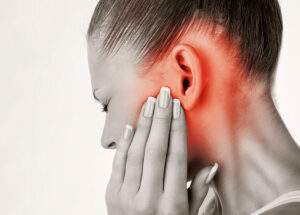
Activities like smiling, chewing, and talking are easy facial movements practically everyone does daily. While comfortable for most, these simple movements can be painful to temporomandibular joint dysfunction (TMJ) sufferers. TMJ symptoms generally resolve in a few weeks to months. However, some behaviors and habits which strain the jaw and neck muscles can also aggravate the condition. While there isn’t much you can do about TMJ, you can get relief and manage its pain from the comfort of your home.
Call Our Office Today at (480) 539-7979
What is TMJ?
Muscles and ligaments used to move your mouth connect to your temporomandibular joints. Various temporomandibular disorders like arthritis, dislocation, or TMJ injury or infection can cause painful jaw clicking and locking, headaches, neck pain, and ringing in the ears.
While these symptoms are generally temporary, the pain and discomfort while moving facial muscles can get chronic for some. The pain worsens with chewing, swallowing, teeth grinding, and clenching of teeth.
Eight best practices for TMJ pain relief
1. Maintain your posture
Always maintain proper posture if you have to sit in the same position for long periods. An improper posture can lead to more jaw pain.
Some useful good posture tips include:
- Using a chair with good back support while working
- Taking frequent breaks
- Setting your seat upright while driving
- Sitting upright with a pillow behind your back for support while doing leisure activities like watching TV or reading
2. Maintain your jaw’s resting position
Minimizing jaw movements like yawning, yelling, singing, and chewing go a long way toward alleviating TMJ pain. Focus on keeping your muscles as relaxed as possible at all times.
3. Sleep tight
Sleep is essential for one’s overall good health. So work at ensuring you get a good night’s sleep. Avoid sleeping on your stomach and if you sleep on your side, don’t place your hand on your jaw. Instead, sleep more on your cack and use the help of pillows for neck support.
4. Applying hot or cold compress
Try alternating between hot and cold compress for 15 to 20 minutes. The heat helps increase blood flow to relax your jaw muscles, while ice helps reduce swelling and pain.
Placing a light layer in between your skin and the compress helps if the heat or cold is too much.
5. Stress reduction
Loosening and relaxing your jaw helps reduce the pain. Yoga practices help reduce the stress on your muscles, while meditation relaxes and loosens your jaw.
6. Jaw exercises
Stretching, strengthening, and relaxation exercise help increase your joint mobility and reduce pain.
7. Avoid certain tendencies and foods
There are a few tendencies and foods that can trigger TMJ like:
- Chewing lips and cheeks
- Nail biting
- Clenching or grinding teeth
- Resting jaws on hands
- Yawning and yelling
- Extensive chewing
- Eating large food bites and crunchy or hard foods
Notice your daily routines and tendencies, and discuss them with your doctor.
8. Surgery
Home pain relief exercises may not help in extreme TMJ pain cases. Your dentist is the best person to decide if you require surgical options like arthroplasty, arthroscopy, or total joint replacement for TMJ pain relief.
Call Our Office Today at (480) 539-7979

